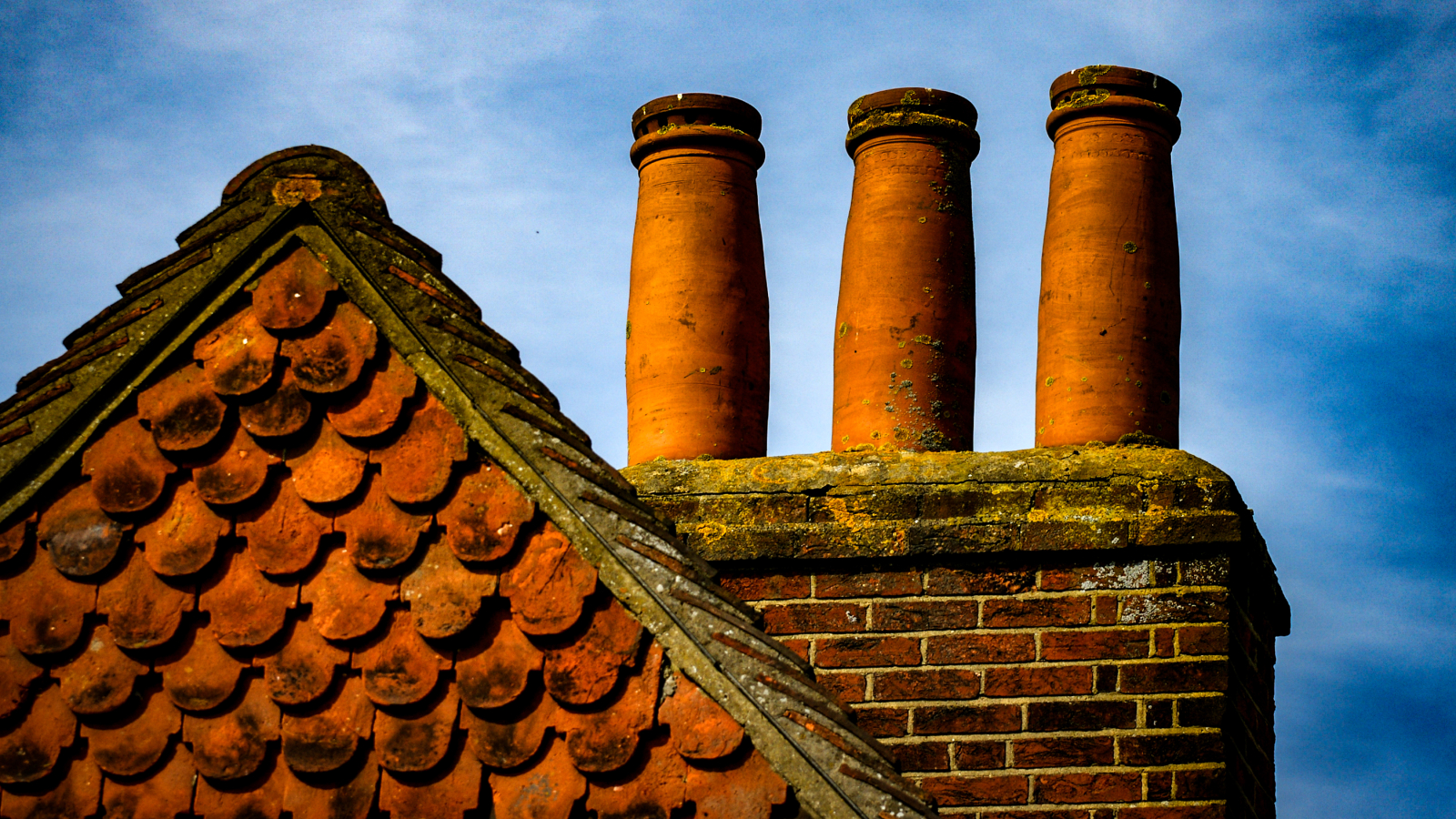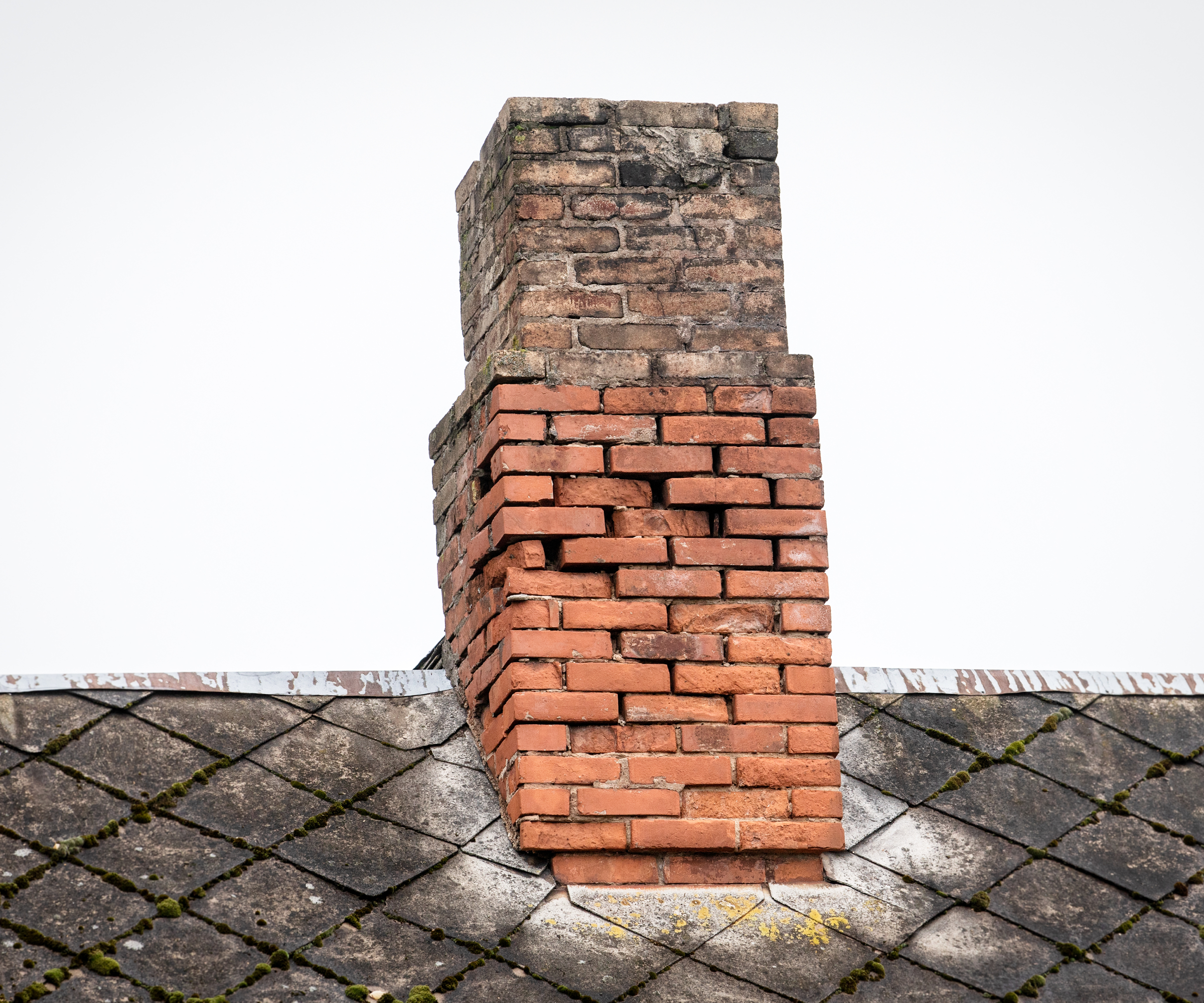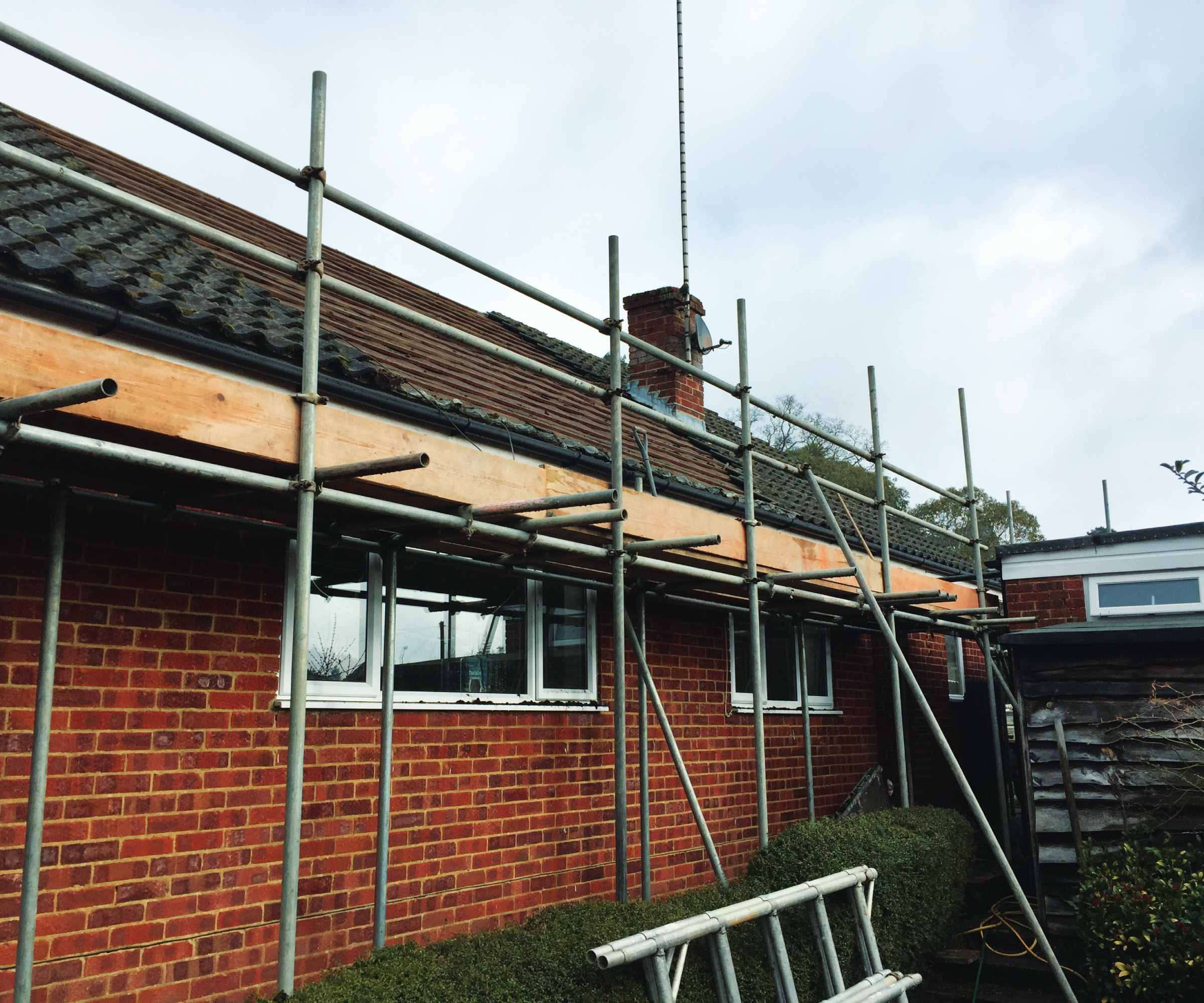Chimney stack removal costs: What you can expect to pay
Wondering what to budget for chimney stack removal costs? Here's what's involved and what you should set aside in your budget for getting the job done well

If you're renovating your property and have inherited a home with chimneys and the stacks aren't needed, or you're adding an extension and need to remove one for practical or aesthetic reasons, you may be considering adding chimney removal costs to your budget.
Or, perhaps it's turning into an area of concern as various parts of it start to break down leading to bigger issues such as damp. Either way, getting rid of it may seem a more sensible option.
But, if you don't already have scaffolding in place and it's a stand-alone job, just what might your chimney stack removal costs stack up to?
Chimney stack removal costs are less likely to involve structural work
The good news is your chimney stack removal costs, unlike chimney breast removal costs, are unlikely to require the professional services of a structural engineer or extra structural work to make your chimney stack safe.
"A chimney stack is the visible part of the chimney which rises above the roofline of a property," explains Thomas Goodman, property and construction expert at MyJobQuote.
"When a chimney stack is removed there will inevitably be a gap in the roof which needs to be covered up to keep your home weathertight, but it is possible to remove a chimney stack without removing the internal parts of the chimney such as the chimney breast."
Therefore, when it comes to chimney stack removal costs above roofline, you will simply be paying to cover up the remaining hole that's left, rather than having to support any elements remaining below.
Bring your dream home to life with expert advice, how to guides and design inspiration. Sign up for our newsletter and get two free tickets to a Homebuilding & Renovating Show near you.
However, if the stack forms a buttress, the whole wall must be checked for stability by a structural engineer before removing the stack above the roofline. This is a much bigger job and may require bigger pockets to pay for the work.

Thomas Goodman has worked in construction industry for over twenty years. Thomas continues to work on building projects, while also providing expert construction and property advice to industry professionals and DIY enthusiasts via the MyJobQuote platform.
Types of chimney stack
While the most common type of chimney stack on older houses is one constructed of masonry, there are also a number of other types of chimney stack.
"Masonry stacks usually made from brick, flashed with lead to stop water ingress and topped with a chimney pot, which in turn may feature a cowl," explains Charlie Avara, director at BUILD by Charlie. "Internally a flue will run through the structure to enable smoke to leave the property.
"A chimney stack is sometimes confused with a chimney breast," she adds, "which is the structure that rises up through the floors of the building and can often take up a good deal of living space.
Thomas Goodman adds: "Prefabricated chimney frames on the other hand are constructed from Glass Reinforced Plastic and then clad with brick slips to replicate a brick-built chimney. They come with fixing kits for rapid and simple installation and removing them is not difficult. However, as these chimney stacks are more often found in newly built homes it’s unlikely you would need to remove one.
"Metal chimneys can be used inside a masonry chimney or as a stand-alone flue. They are typically double-walled to protect the surrounding materials in the roof space. If you are removing a wood-burning stove from a property you may need to take down the metal flue. This is not difficult but the gap it leaves in the roof will still need to be closed up."

After a very successful career as MD of a design and build company Charlie has recently launched her own domestic contracting business, BUILD by Charlie. With over 15 years in the industry Charlie has built up a wealth of knowledge on all things renovating and remodelling with a proven track record of delivering on projects ranging from the ultra modern, through to period properties, working with architects or directly with the homeowners.

Reasons for removal
Before we investigate the full picture of chimney stack removal costs, it's worth considering the reasons why you may want to remove one.
"As with all elements of a building, what one person considers a carefully chosen design feature, another might think of as an eyesore. In addition to this, chimney stacks are one of the most exposed parts of any building and require ongoing upkeep," explains Charlie Avara. "Removing the chimney stack is a simple way to overcome both of these factors.
"However, a chimney stack should only be removed if the fires connecting to it are no longer in use," says Charlie. "For example, if the original wood or coal burning fireplace has been replaced with an imitation fireplace, in this instance it is possible to remove just the chimney stack and make the roof good afterwards.
"It does get slightly more complicated if you are planning to remove a chimney stack that you share with a neighbour," she adds. "If you intend to remove half of a stack that you share with a neighbour, this is notifiable under the Party Wall Act as you will be leaving the previously internal party wall exposed - something that was not intended at the time of building.
"If you are concerned a good rule of thumb is to consult a party wall surveyor who will be able to help you navigate the legalities and complexities of this process.
In general, the main reasons for considering chimney stack removal costs are as follows:
- The chimney stack is in poor condition and poses a danger
- Leaks are occurring as a result of the condition of the chimney stack causing issues with damp
- To reduce maintenance costs - even if not used it will still need to be kept in good condition
- You want to remove the chimney breast inside your home to create more space and the chimney stack is supported by the chimney breast. Removing it may be simpler than the structural work needed to support the stack once the breast is removed
- For aesthetic reasons - you prefer a cleaner roof line
- You're considering a two storey extension or loft conversion and it has to be removed
How a chimney stack is made
A masonry chimney stack is made up of the following parts, all of which will need to be removed:
- Flue - found inside the chimney stack and it's the aperture which vents smoke and gases from the fire or wood burner to the outside
- Chimney pot - found at the top of the flue. It extends the length of the chimney stack and facilitates the creation of a draught to aid combustion in the fire below. The chimney pot may have a cowl which further aids air flow, prevents downdraughts and stops birds from nesting in the chimney pot
- Flaunching - a strong mortar which holds the chimney pot in place and acts as a rainwater barrier from preventing moisture entering the stack
- Flashing - a band of metal, typically lead, which acts as a water-tight seal between the roof and the stack. Occasionally, this flashing may be constructed from mortar
Removing a chimney stack - what's involved
Removing a chimney stack involves the following process.
"It goes without saying that removing a chimney stack involves working at height, so hiring a cherry picker or putting us scaffolding is an essential first step," says Charlie Avara. "Not only as a means of working safely but also to help you get the materials back to the ground safely."
"The first step in the deconstruction proccess is to remove the flaunching, giving you access to the chimney pots which also have to come out," says Thomas Goodman. "Once the flaunching is gone you can remove each course of bricks from the chimney stack one at a time."
You will then need to make good the roof explain both of our experts.
"To do this new roofing felt or breathable membrane will need to be installed, followed by battens and roof tiles," says Charlie. "It is always worth putting time into sourcing reclaimed roof tiles," she adds, "after all a patch of perfectly new tiles will be a bit of an eyesore on a weathered roof.
"The final phase of the project is getting rid of the materials and before you put everything into skip it might be worth considering selling the bricks and the pot," suggest Charlie, "after all if your chimney stack were made of London Yellow Stock bricks for example people are always on the lookout for these for building projects."
Factors affecting chimney stack removal costs
The main factors affecting your chimney stack removal costs are:
- Condition of current stack and roof
- Need for scaffolding
- Labour
- Materials
- Skip hire
- Level of repairs required post removal
- Building regulations requirements
- Planning permission/Permitted development
- Party wall agreement (if applicable)

"If the chimney stack is in a poor state of repair, the process of taking it down will have to be slow and careful," advises Thomas Goodman. "This can increase the cost of the work. Rushing the job could risk the stack falling or bricks crashing onto your roof or into neighbouring properties."
Of course, if during removal you also discover underlying issues you weren't aware of, such as damp in your loft space, you will need to cover the cost of the work to repair this as well.
"Even with the most careful of workers, your roof may incur some damage during the removal of a chimney stack," adds Thomas, "so the repair costs will have to be added to the final price that you pay."
"The final chimney stack removal cost will depend on the size and complexity of the stack being removed," agrees Charlie Avara. "The largest cost is likely to be the labour of the professional carrying out the work and the access to the chimney stack.
"I would recommend budgeting upwards of £6000 as a full package cost including scaffolding and retiling the roof."
Scaffolding
The height of your roof, position of the chimney stack, accessibility and overall safety will all have an impact on the cost of your scaffolding.
If for example it needs to be wrapped around two sides of your home, or you discover damage that takes longer to repair than anticipated this will increase the cost. As an average, you can expect to pay around £20-25 per sqm of scaffolding says Thomas.
Labour
"The price of labour will depend on where in the country you live," says Thomas, "as prices in London and the South East are typically higher. However, you can expect to pay around £200-£300 per day for labour costs."
And whilst the length of time it takes to remove it will depend on the size of the stack and what you uncover when you start the work, "the work can normally be done in one working day," says Thomas, "but this this doesn’t include erecting the scaffolding or the removal of the waste."
Materials
Basic maths dictates that the cost of materials to fill in the gap left in your roof will naturally depend on how large a hole is left and the type of materials required.
"You may need some timber to infill rafters and add some battons," says Thomas. "Enough roofing membrane and tiles or slates to cover the gap will also be required."
While you will be required to cover the hole with the same finish as the rest of your roof, it's worth knowing in advance that the cost of tiles is generally less than slate. Thomas estimates that a welsh slate will cost around £5 per slate, whereas roof tiles which are typically made from concrete will cost between £1-3 per tile. Breathable membrane and treated roof battons will respectively set you back around £1.28 and £1.20 per metre.

Skip hire
As with materials, the amount of waste generated from removing a chimney stack will dictate the size of the skip required. As will the possible need to keep it on site for longer if you have to do remedial repair work.
"If you don’t have a garden to put the skip in," notes Thomas, "you will also have to pay for a permit for the skip to go on the public highway. The cost of this will be determined by your local authority, although most skip-hire companies will organize this for you and add the fee to the overall cost of skip hire."
"An average 10-yard skip will cost around £200-£400," advises Thomas.
Permitted Development
According to the Planning Portal experts:
"Fitting, altering or replacing an external flue, chimney, or soil and vent pipe is normally considered to be permitted development, not requiring planning consent."
However, there are conditions linked to designated and conservation areas and of course to listed buildings. If you live in a listed building it's likely you will need listed building consent to remove your chimney stack. Likewise if you live in a conservation area, you should always check with your building control officer what is permitted.
However, if you meet the requirements for permitted development, you shouldn't need to factor this into your chimney stack removal costs.
Building Regulations
For the purpose of removing your chimney stack above the roofline, you will be required to ensure that the work falls in line with Part A of Building Regulations which relates to structure. It sets the standards to ensure you cover up the hole in the roof caused by removing the stack, with the same materials used to form the current roof structure.
You will need to inform your building control department about the work and ensure it is signed off by the council or an approved inspector. This could cost around £200 & VAT.
Party Wall Act
If your chimney stack is on a shared wall, you will be required to consult and inform your neighbour under the Party Wall Act. Legal fees for arranging this may cost upwards of £700 & VAT.
What to budget for your chimney stack removal costs
| ITEM | ESTIMATED COSTS* |
|---|---|
| Scaffolding | £20-25 per metre |
| Skip | £200-400 per skip |
| Labour | £200-300 per day |
| Materials | £1-5 per tile or slate, £1.28 per metre of waterproof membrane, £1.20 per treated batton |
| Building regulations | £200 plus VAT for independent inspector |
* Average costs excluding listed building applications or party wall agreements
FAQs
Are chimney stack removal costs cheaper than repair or maintenance?
"Depending on the condition of the chimney stack it may be cheaper to have it removed rather than trying to repair it," says Thomas Goodman. "If you have no fuel-burning appliances in your home that require a chimney, or a neighbour with one if you share a stack, removing it is often the best option - particularly if it’s in bad condition."
If you're renovating a property and don't plan on using any open fireplaces, unless you have capped them off or fitted a chimney balloon, they will also be creating a draught and costing you more money in energy bills.
Even if it's not in use, a chimney stack will still need regular maintenance, so "if your chimney stack serves no practical purpose, is in bad condition and you are happy to live without it," says Thomas, "then removal is cheaper than repairing it."
Can I remove a chimney stack myself?
Both our experts strongly replied no when asked this question.
"I would strongly recommend using a professional if you are looking to remove a chimney stack," says Charlie Avara. "The combination of working at height, ensuring that the roof is watertight and that the finished project is compliant with building regulations mean that the job is best left to the professionals.
"Removing a chimney stack involves taking down heavy chimney pots, cement flaunching and several courses of bricks, all without dropping anything on your roof and causing damage. Or worse, injuring yourself or others," warns Thomas Goodman.
It's also not withstanding the potential for damage to the rest of your roof if you do the job incorrectly. "While it may be tempting to forego hiring a professional for this job, don’t underestimate how difficult it can be," says Thomas.
Even if you don't use your chimney with a working fireplace, it's worth remembering that it will still require on-going maintenance like the rest of your home. However, if you think any current damage isn't enough to incur the risk of debris falling onto the ground, or you're keen to keep it as an architectural feature, find out all you need to know about restoring chimneys and read our step-by-step guide to repointing a chimney to find out just what's involved.

Sarah is Homebuilding & Renovating’s Assistant Editor and joined the team in 2024. An established homes and interiors writer, Sarah has renovated and extended a number of properties, including a listing building and renovation project that featured on Grand Designs. Although she said she would never buy a listed property again, she has recently purchased a Grade II listed apartment. As it had already been professionally renovated, she has instead set her sights on tackling some changes to improve the building’s energy efficiency, as well as adding some personal touches to the interior.
